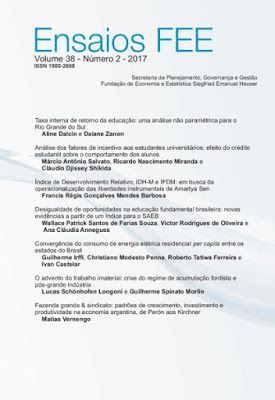Summary:
New paper published in Ensaios FEE. In all fairness, this was the paper that should have been published in 2013 in the volume organized by Ricardo Bielschowky and available here. But the revisions took longer than expected. It is in Portuguese, however. Below the English abstract. This paper analyzes the three phases of Argentine economic development since the end of the 19th century, namely: the commodity export model, the period of state-led industrialization and the neoliberal reforms initiated in the 1970s, and complemented in the 1990s. The main argument is that the commodity export model had run its course, given the geopolitical changes in the world, and that the abandonment of the industrialization project had less to do with its own limitations, and more to do with the
Topics:
Matias Vernengo considers the following as important: Argentina, Economic Development
This could be interesting, too:
New paper published in Ensaios FEE. In all fairness, this was the paper that should have been published in 2013 in the volume organized by Ricardo Bielschowky and available here. But the revisions took longer than expected. It is in Portuguese, however. Below the English abstract. This paper analyzes the three phases of Argentine economic development since the end of the 19th century, namely: the commodity export model, the period of state-led industrialization and the neoliberal reforms initiated in the 1970s, and complemented in the 1990s. The main argument is that the commodity export model had run its course, given the geopolitical changes in the world, and that the abandonment of the industrialization project had less to do with its own limitations, and more to do with the
Topics:
Matias Vernengo considers the following as important: Argentina, Economic Development
This could be interesting, too:
Matias Vernengo writes Milei and real wages in Argentina
Joel Eissenberg writes Javier Milei: Argentina’s Trump?
Merijn T. Knibbe writes Superinflation in Milei´s Argentina
Matias Vernengo writes Podcast with about the never ending crisis in Argentina
New paper published in Ensaios FEE. In all fairness, this was the paper that should have been published in 2013 in the volume organized by Ricardo Bielschowky and available here. But the revisions took longer than expected. It is in Portuguese, however. Below the English abstract.
This paper analyzes the three phases of Argentine economic development since the end of the 19th century, namely: the commodity export model, the period of state-led industrialization and the neoliberal reforms initiated in the 1970s, and complemented in the 1990s. The main argument is that the commodity export model had run its course, given the geopolitical changes in the world, and that the abandonment of the industrialization project had less to do with its own limitations, and more to do with the political implications of the model. In particular, the higher wages needed for mass consumption led to recurrent balance of payments problems, and a political backlash that made it ultimately unsustainable. The limits of the abandonment of the neoliberal project during the last commodity boom are briefly discussed.

